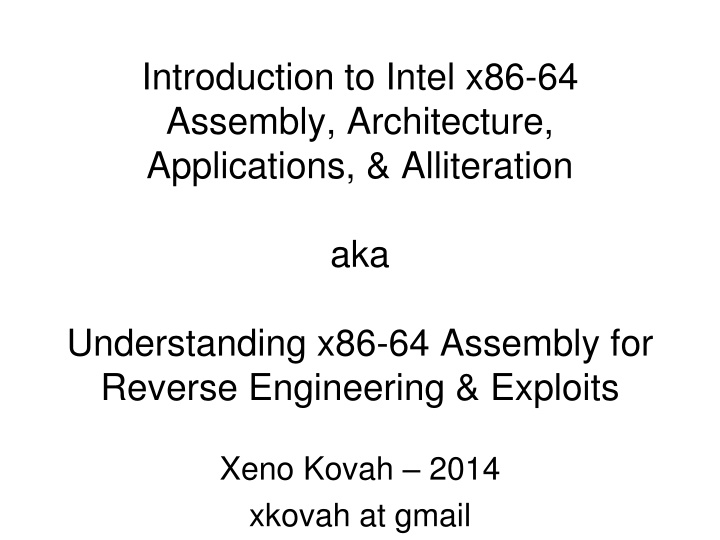
x86-64 Assembly for Reverse Engineering and Exploits
Explore the world of Intel x86-64 assembly language with this comprehensive guide by Xeno Kovah. Learn about architecture, applications, and alliteration as you delve into the essential knowledge for reverse engineering and exploiting. Discover why learning x86 assembly is crucial and how it opens doors to a deeper understanding of security and hacking techniques. Special thanks to contributors and additional content providers who enrich this resource for aspiring hackers and security enthusiasts.
Download Presentation

Please find below an Image/Link to download the presentation.
The content on the website is provided AS IS for your information and personal use only. It may not be sold, licensed, or shared on other websites without obtaining consent from the author. If you encounter any issues during the download, it is possible that the publisher has removed the file from their server.
You are allowed to download the files provided on this website for personal or commercial use, subject to the condition that they are used lawfully. All files are the property of their respective owners.
The content on the website is provided AS IS for your information and personal use only. It may not be sold, licensed, or shared on other websites without obtaining consent from the author.
E N D
Presentation Transcript
Introduction to Intel x86-64 Assembly, Architecture, Applications, & Alliteration aka Understanding x86-64 Assembly for Reverse Engineering & Exploits Xeno Kovah 2014 xkovah at gmail
All materials is licensed under a Creative Commons Share Alike license. http://creativecommons.org/licenses/by-sa/3.0/ Attribution condition: You must indicate that derivative work "Is derived from Xeno Kovah's 'Intro x86-64 class, available at http://OpenSecurityTraining.info/IntroX86-64.html
Special Thanks To: Veronica Kovah & Sam Cornwell, for helping with the update for 64 bit!
Additional Content/Ideas/Info Provided By: Jon A. Erickson, Christian Arllen, Dave Keppler, Dillon Beresford Who suggested what, is inline with the material Your name here! Just suggest/contribute some content that ultimately makes its way into the class
Why learn x86 assembly? Because x86 is pervasive on PCs & servers (and you better believe that Intel is going to claw their way on to mobile ;)) Because it s basically a given that some talk at a security conference will at some point flash some x86 assembly in order to explain what s going on. But even more talks just assume you know it and will be able to fill in the implied asm next steps. Because it s essential to writing memory corrupting exploits on PCs & servers Because it s essential to reverse engineering programs (goodware or malware) on Because there are plenty of people who know network security but those who know host-based security are more rare and therefore more valuable Because all the other architectures are super simple by comparison and easier to learn afterwards Because a lot of the top hackers who have come before you knew x86 assembly, and in order to get to where they got, you need to know what they knew
Defeating Signed BIOS Enforcement - Kallenberg et al., HITB 2013 6
Full System Emulation: Achieving Successful Automated Dynamic Analysis of Evasive Malware, Kruegel, BlackHat USA 2014 8
Exposing Bootkits with BIOS Emulation - Haukli, BlackHat USA 2014 9
Governments as Malware Authors - Hypponen, BlackHat USA 2014
About Me Security nerd T-Shaped!1 Realmz ~1996, Mac OS 8, BEQ->BNE FTW! x86 ~2002 Know or have known ~5 assembly languages(x86, SPARC, ARM, PPC, 68HC12). x86 is by far the most complex. Routinely read assembly when debugging my own code, reading exploit code, and reverse engineering things 1http://www.valvesoftware.com/company/Valve_Handbook_LowRes.pdf
About You? Name & Company Why did you want to take the class? If you know you will be applying this knowledge, to which OS and/or development environment?
About the Class The intent of this class is to expose you to the most commonly generated assembly instructions, and the most frequently dealt with architecture hardware. 64 bit instructions/hardware Implementation of a Stack Common tools Many things will therefore be left out or deferred to later classes. Floating point instructions/hardware 16 bit instructions/hardware Complicated or rare instructions Instruction pipeline, caching hierarchy, alternate modes of operation, hw virtualization, etc (see other classes for those)
About the Class 2 The hope is that the material covered will be provide the required background to delve deeper into areas which may have seemed daunting previously. Because I can t anticipate the needs of all job classes, if there are specific areas which you think would be useful to certain job types, let me know. The focus areas are currently primarily influenced by my security background, but I would like to make the class as widely applicable as possible.
Agenda Day 1 - Part 1 - Architecture Introduction, Windows tools Day 1 - Part 2 - Windows Tools & Analysis, Learning New Instructions Day 2 - Part 1 - Linux Tools & Analysis Day 2 - Part 2 - Inline Assembly, Read The Fun Manual, Choose Your Own Adventure
Book Whenever you see Book page * mentioned throughout the class, it is referring to Professional Assembly Language by Richard Blum. This optional book was originally picked after the creation of the 32 bit class because it uses AT&T assembly syntax & linux as an example, in contrast to the majority of this class. Therefore it just serves as an alternative source of explanation in case something from the class isn t clear and you want a second opinion
Book 2 If I were to pick a new book for this class, it would probably be Introduction to 64 Bit Assembly Programming for Linux and OS X: Third Edition by Ray Seyfarth I haven t got around to buying a copy yet to look through it, but based on the Amazon preview it looks generally like what I m looking for in a class book (mostly just that it s using 64 bit. ;) Whereas the previous book is 32 bit only.) Once I get around to buying a copy and evaluating it, I ll update the class materials to indicate they re referring only to this book
Miss Alaineous Questions: Ask em if you got em If you fall behind and get lost and try to tough it out until you understand, it s more likely that you will stay lost, so ask questions ASAP. Browsing the web and/or checking email during class is a good way to get lost 2 hours, 10 min break, 1.5 hours, lunch, 1 hour/5 min break after that It s called x86 because of the progression of Intel chips from 8086, 80186, 80286, etc. I just had to get that out of the way. :)
Miss Alaineous 2 Intel originally wanted to break from x86 when moving to 64 bit. This was Itanium aka IA64 (Intel Architecture 64 bit). However, AMD decided to extend x86 to 64 bits itself, leading to the AMD64 architecture. When Itanium had very slow adoption, Intel decided to bite the bullet and license the 64 bit extensions from AMD. In the Intel manuals you will see the 64 bit extensions referred to as IA32e or EMT64 or Intel 64 (but never IA64. Again, that's Itanium, a completely different architecture). You might sometimes see it called amd64 or x64 by MS or some linux distributions In this class we're going to go with x86-64
What youre going to learn: #include <stdio.h> int main(){ printf( Hello World!\n ); return 0x1234; }
Is the same as main: 000000013F511000 sub rsp,28h 000000013F511004 lea rcx,[__globallocalestatus-10h (13F513000h)] 000000013F51100B call qword ptr [__imp_printf (13F512100h)] 000000013F511011 mov eax,1234h 000000013F511016 add rsp,28h 000000013F51101A ret Windows Visual C++ 2012 Express /GS (buffer overflow protection) option turned off Disassembled with Visual C++
which could be viewed as 0000000140001000 <.text>: 140001000: 48 83 ec 28 sub $0x28,%rsp 140001004: 48 8d 0d ad 11 00 00 lea 0x11ad(%rip),%rcx # 0x1400021b8 14000100b: ff 15 07 11 00 00 callq *0x1107(%rip) # 0x140002118 140001011: b8 34 12 00 00 mov $0x1234,%eax 140001016: 48 83 c4 28 add $0x28,%rsp 14000101a: c3 retq Windows Visual C++ 2012 Express /GS (buffer overflow protection) option turned off Disassembled with objdump -d from cygwin
which is equivalent to 08048374 <main>: 8048374: 8d 4c 24 04 8048378: 83 e4 f0 804837b: ff 71 fc 804837e: 55 804837f: 89 e5 8048381: 51 8048382: 83 ec 04 8048385: c7 04 24 60 84 04 08 804838c: e8 43 ff ff ff 8048391: b8 2a 00 00 00 8048396: 83 c4 04 8048399: 59 804839a: 5d 804839b: 8d 61 fc 804839e: c3 804839f: 90 lea 0x4(%rsp),%rcx and $0xfffffff0,%rsp pushl -0x4(%rcx) push %rbp mov %rsp,%rbp push %rcx sub $0x4,%rsp movl $0x8048460,(%rsp) call 80482d4 <puts@plt> mov $0x1234,%eax add $0x4,%rsp pop %rcx pop %rbp lea -0x4(%rcx),%rsp ret nop Ubuntu 12.04, GCC 4.2.4 Disassembled with objdump -d
which is equivalent to _main: 0000000100000f40 0000000100000f41 0000000100000f44 0000000100000f48 "Hello World!" 0000000100000f4f 0000000100000f56 0000000100000f58 0000000100000f5d 0000000100000f62 0000000100000f65 0000000100000f67 0000000100000f6b 0000000100000f6c pushq %rbp movq subq leaq %rsp, %rbp $0x10, %rsp 0x3f(%rip), %rdi ## literal pool for: movl movb callq 0x100000f6e ## symbol stub for: _printf movl $0x1234, %ecx movl %eax, -0x8(%rbp) movl %ecx, %eax addq $0x10, %rsp popq %rbp ret $0x0, -0x4(%rbp) $0x0, %al Mac OS 10.9.4, Apple LLVM version 5.1 (clang-503.0.40) Disassembled from command line with otool -tV
But it all boils down to .text:0000000140001000 main .text:0000000140001000 .text:0000000140001000 sub rsp, 28h .text:0000000140001004 lea rcx, Format ; "Hello World!\n" .text:000000014000100B call cs:__imp_printf .text:0000000140001011 mov eax, 1234h .text:0000000140001016 add rsp, 28h .text:000000014000101A retn Windows Visual C++ 2012, /GS (buffer overflow protection) option turned off Optimize for minimum size (/O1) turned on Disassembled with IDA Pro 6.6 (with some omissions for fitting on screen)
Take Heart! By one measure, only 14 assembly instructions account for 90% of code! http://www.blackhat.com/presentations/bh-usa-06/BH-US-06-Bilar.pdf I think that knowing about 20-30 (not counting variations) is good enough that you will have the check the manual very infrequently You ve already seen 10 instructions, just in the hello world variations!
















